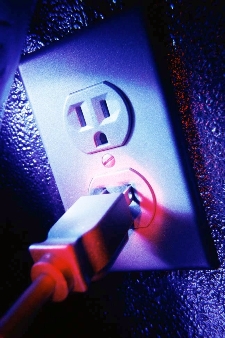Power Surges
 A power surge is a variation in electrical voltage. A power surge, which lasts less than 1/100th of a second, can range from five to 10 volts when you turn on your hair dryer, to thousands of volts if lightning strikes a transformer.
A power surge is a variation in electrical voltage. A power surge, which lasts less than 1/100th of a second, can range from five to 10 volts when you turn on your hair dryer, to thousands of volts if lightning strikes a transformer.
Large power surges, such as lightning, can instantly ruin your TV, computer and other electronics. Smaller "everyday" surges can slowly destroy your expensive electric appliances – a process called "electronic rust."
What causes power surges?
Up to 80 percent of all power surges originate within the home – when devices with motors shut off or start up, diverting energy to and from other appliances. Common culprits of internal surges are power tools, refrigerators, printers and hair dryers.
External power surges are generally caused by uncontrollable events, such as lightning strikes, animals interfering with electrical equipment, vehicle accidents with utility poles, etc.
Is Wake Forest Power responsible for power surges?
Wake Forest Power is responsible only for surges that occur due to negligence of our personnel. Most surges are caused by factors outside of the control of telephone, cable and electric utilities.
We are not responsible for surges caused by lightning, animals, tree limbs, faulty wiring or surges created within your home or beyond control of Wake Forest Power.

How can I protect my home electronics from power surges?
The best way to prevent damage from power surges is to invest in high-quality surge protectors. All programmable appliances should be connected to a surge protector, including home entertainment systems, computer equipment and other digital devices.
Also remember that power surges can come into your home through other utility lines as well as electrical, so be sure to connect incoming cable and satellite TV lines, and all telephone lines, including fax and modem.
Why do my digital clocks flash "12:00" sometimes?
This phenomenon is known as a "power blink." It's annoying, but it's actually preventing longer power outages.
When a tree limb or other obstruction comes into contact with a power line, a circuit breaker automatically trips to prevent power from surging back into the system and causing an outage. After a fraction of a second, it will automatically reset.
